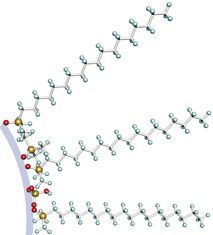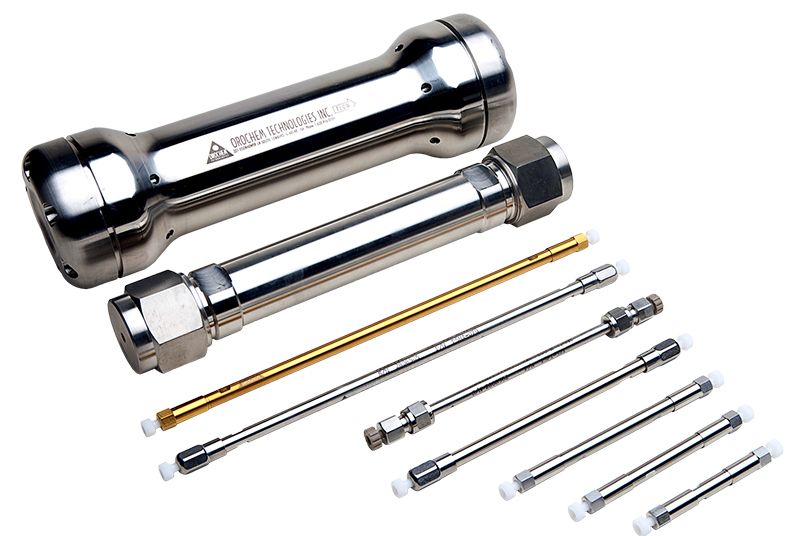
Are you looking to separate and analyze complex mixtures of chemicals and biomolecules in a fast and efficient manner? High-performance liquid chromatography (HPLC) is a powerful analytical technique that can meet your needs. The heart of an HPLC system is the column, where the separation of analytes takes place. In this article, we will cover the basics of HPLC columns, their types, and their applications in different industries.
Basics of HPLC Columns
Discover how HPLC columns are essential technology for separating chemical compounds in industry and how they can aid in your research.
HPLC columns are long, narrow tubes filled with a stationary phase and a mobile phase that flows through it. The stationary phase is a solid or a liquid that is immobilized on a support material, such as silica or polymer particles. The mobile phase is a liquid that carries the analyte mixture through the column. As the mobile phase flows through the stationary phase, different analytes interact with the stationary phase differently, resulting in separation.
Column Packing Material
The packing material in an HPLC column is crucial for separation efficiency and selectivity. The packing material should have a high surface area, uniform pore size, and good mechanical stability. Silica-based materials are the most commonly used packing materials due to their high surface area and uniformity. Other types of packing materials include polymer-based materials, hybrid materials, and monolithic materials.
Column Dimensions
Column dimensions, including the length, inner diameter, and particle size of the packing material, are essential for optimizing separation performance. Longer columns can provide higher resolution but require more time and mobile phase. Smaller particle size can lead to higher resolution but also require higher pressure and may lead to column clogging.
Column Chemistry
The chemical properties of the stationary phase can influence separation selectivity. Different types of stationary phases, such as reversed-phase, normal-phase, ion-exchange, size-exclusion, and chiral phases, can separate analytes based on different chemical interactions, such as hydrophobicity, polarity, charge, size, and stereochemistry.
Column End-Fittings
The end-fittings of an HPLC column can affect the flow rate, pressure, and sealing of the column. Different types of end-fittings, such as compression fittings, finger-tight fittings, and quick-connect fittings, can be used depending on the column and instrument requirements.
Types of HPLC Columns
Different types of HPLC columns can provide different separation mechanisms and selectivities for various applications.
Reverse Phase HPLC Columns: Separating Hydrophobic Compounds
Reverse phase high-performance liquid chromatography (RP-HPLC) is a widely used technique for separating hydrophobic compounds, such as lipids, proteins, and peptides. In RP-HPLC, the stationary phase is hydrophobic, and the mobile phase is polar or aqueous. This results in the retention of hydrophobic analytes on the column, allowing for their separation based on their polarity and hydrophobicity.
The stationary phase in RP-HPLC is typically a hydrophobic material, such as a silica gel, that has been modified with hydrophobic groups, such as octadecyl (C18) or octyl (C8) chains. The hydrophobic nature of the stationary phase allows for the retention of hydrophobic analytes, while the polar mobile phase can wash away polar contaminants and impurities.
The mobile phase in RP-HPLC is typically an aqueous buffer, such as phosphate or acetate, that contains an organic modifier, such as acetonitrile or methanol. The organic modifier is used to increase the hydrophobicity of the mobile phase, allowing for the elution of hydrophobic analytes from the column.
RP-HPLC is used in many fields, such as pharmaceuticals, biotechnology, food and beverage, and environmental analysis, for various purposes, such as analysis, purification, and quality control. RP-HPLC is particularly useful for separating and quantifying hydrophobic compounds, such as drugs, lipids, and proteins, which are difficult to analyze using other techniques.
Reverse phase high-performance liquid chromatography (RP-HPLC) is a powerful analytical technique for separating and quantifying hydrophobic compounds in complex mixtures. With its hydrophobic stationary phase and polar mobile phase, RP-HPLC allows for the retention and elution of hydrophobic analytes based on their polarity and hydrophobicity. RP-HPLC is widely used in various industries for analysis, purification, and quality control, and plays a crucial role in advancing scientific knowledge and applications.
Normal Phase HPLC Columns: Separating Polar Compounds
Normal phase high-performance liquid chromatography (NP-HPLC) is a technique used to separate polar compounds, such as carbohydrates, amino acids, and organic acids. In NP-HPLC, the stationary phase is polar, and the mobile phase is nonpolar. This results in the retention of polar analytes on the column, allowing for their separation based on their polarity and hydrophobicity.
The stationary phase in NP-HPLC is typically a polar material, such as silica gel or alumina, that has been modified with polar functional groups, such as diol or cyano. The polar nature of the stationary phase allows for the retention of polar analytes, while the nonpolar mobile phase can wash away nonpolar contaminants and impurities.
The mobile phase in NP-HPLC is typically a nonpolar solvent, such as hexane or heptane, that contains a polar modifier, such as methanol or water. The polar modifier is used to increase the polarity of the mobile phase, allowing for the elution of polar analytes from the column.
NP-HPLC is used in many fields, such as biochemistry, environmental science, and food and beverage analysis, for various purposes, such as analysis, purification, and quality control. NP-HPLC is particularly useful for separating and quantifying polar compounds, such as amino acids and organic acids, which are difficult to analyze using other techniques.
Normal phase high-performance liquid chromatography (NP-HPLC) is a powerful analytical technique for separating and quantifying polar compounds in complex mixtures. With its polar stationary phase and nonpolar mobile phase, NP-HPLC allows for the retention and elution of polar analytes based on their polarity and hydrophobicity. NP-HPLC is widely used in various industries for analysis, purification, and quality control, and plays a crucial role in advancing scientific knowledge and applications.
Ion-Exchange Columns: Separating Charged Molecules
Ion-exchange chromatography (IEC) is a technique used to separate and purify charged molecules, such as proteins, nucleic acids, and carbohydrates. In IEC, the stationary phase contains charged functional groups, while the mobile phase contains ions of opposite charge. This results in the retention of charged analytes on the column, allowing for their separation based on their charge and affinity to the stationary phase.
The stationary phase in IEC is typically a resin or polymer that contains charged functional groups, such as carboxylic acid or amino groups. These functional groups can be either cationic or anionic, depending on the desired separation. Cationic stationary phases are used to separate anionic analytes, while anionic stationary phases are used to separate cationic analytes.
The mobile phase in IEC is typically an aqueous buffer solution containing ions of opposite charge to the stationary phase. For example, if the stationary phase is cationic, the mobile phase will contain anions, such as chloride or sulfate ions. The concentration and pH of the mobile phase can also be adjusted to optimize the separation of charged analytes.
IEC is used in many fields, such as biotechnology, pharmaceuticals, and food and beverage analysis, for various purposes, such as purification, separation, and analysis. IEC is particularly useful for separating and purifying proteins, nucleic acids, and other charged biomolecules, which are important in many biological and medical applications.
Ion-exchange chromatography (IEC) is a powerful analytical technique for separating and purifying charged molecules in complex mixtures. With its charged stationary phase and mobile phase containing ions of opposite charge, IEC allows for the retention and elution of charged analytes based on their charge and affinity to the stationary phase. IEC is widely used in various industries for purification, separation, and analysis of charged biomolecules, and plays a crucial role in advancing scientific knowledge and applications.
Size-Exclusion Columns: Separating Molecules Based on Size
Size-exclusion chromatography (SEC), also known as gel filtration chromatography, is a technique used to separate molecules based on their size. In SEC, the stationary phase is composed of porous beads, while the mobile phase is a buffer solution. Larger molecules are excluded from entering the pores and therefore elute first, while smaller molecules enter the pores and elute later.
The stationary phase in SEC is composed of porous beads, typically made of cross-linked agarose or polymeric materials. The pores within the beads have a specific size exclusion limit, which determines the range of molecules that can enter and be separated. The stationary phase is often packed into a column to increase the surface area and efficiency of the separation.
The mobile phase in SEC is typically an aqueous buffer solution, which helps to maintain the stability and solubility of the molecules being separated. The composition and pH of the mobile phase can also be adjusted to optimize the separation based on the properties of the molecules being separated.
SEC is used in various fields, such as biochemistry, biotechnology, and pharmaceuticals, for various purposes, such as protein purification, analysis of protein complexes, and determination of molecular weight distribution. SEC is particularly useful for separating and analyzing large molecules, such as proteins, nucleic acids, polysaccharides, and synthetic polymers.
Size-exclusion chromatography (SEC) is a powerful analytical technique for separating molecules based on their size. With its porous stationary phase and mobile phase containing a buffer solution, SEC allows for the separation of molecules based on their size exclusion limit. SEC is widely used in various industries for protein purification, analysis of protein complexes, and determination of molecular weight distribution, and plays a crucial role in advancing scientific knowledge and applications.
Chiral Columns: Separating Enantiomers
Chiral chromatography, also known as enantioselective chromatography, is a technique used to separate enantiomers, which are mirror images of each other that cannot be superimposed. In chiral chromatography, a chiral stationary phase is used, which selectively interacts with one enantiomer over the other, allowing for their separation.
The stationary phase in chiral chromatography is a chiral material, which has a three-dimensional structure that is asymmetrical and can interact selectively with one enantiomer over the other. Chiral stationary phases are made of various materials, such as cellulose, amylose, and cyclodextrin, and can be coated onto silica or polymer particles to create a column.
The mobile phase in chiral chromatography is typically a polar organic solvent, such as methanol or acetonitrile, mixed with a buffer solution. The composition and pH of the mobile phase can also be adjusted to optimize the separation based on the properties of the molecules being separated.
Chiral chromatography is used in various fields, such as pharmaceuticals, agrochemicals, and food science, for various purposes, such as drug development, quality control, and analysis of natural products. Chiral chromatography is particularly useful for separating and analyzing enantiomers of drugs, which often exhibit different pharmacological and toxicological properties.
Chiral chromatography is a powerful analytical technique for separating enantiomers, which are mirror images of each other that cannot be superimposed. With its chiral stationary phase and polar organic mobile phase, chiral chromatography allows for the selective separation of enantiomers based on their interactions with the stationary phase. Chiral chromatography is widely used in various industries for drug development, quality control, and analysis of natural products, and plays a crucial role in advancing scientific knowledge and applications.
Applications of HPLC Columns
Discover the many applications of HPLC columns in science and industry, including pharmaceuticals, environmental analysis, and more.
HPLC columns have a wide range of applications in various industries.
Pharmaceutical Industry
HPLC columns are commonly used in drug discovery, development, and quality control. They can separate and quantify drug compounds, impurities, and degradation products in complex matrices, such as plasma, urine, and tablets.
Food and Beverage Industry
HPLC columns are used to analyze food and beverage samples for quality control, safety, and authenticity. They can separate and quantify various components, such as vitamins, amino acids, sugars, and additives, and detect contaminants, such as pesticides, mycotoxins, and antibiotics.
Environmental Analysis
HPLC columns are used to monitor and analyze environmental samples, such as water, soil, and air, for pollutants and contaminants. They can separate and quantify various compounds, such as pesticides, herbicides, polycyclic aromatic hydrocarbons (PAHs), and heavy metals.
Forensic Science
HPLC columns are used to analyze forensic samples, such as blood, urine, and tissues, for drugs, toxins, and poisons. They can separate and quantify various compounds, such as opiates, cannabinoids, cocaine, and metabolites.
Biotechnology Industry
HPLC columns are used to analyze and purify biopharmaceuticals, such as proteins, peptides, and nucleic acids. They can separate and quantify various impurities, such as host cell proteins, DNA, and endotoxins, and detect contaminants, such as pesticides, mycotoxins, and antibiotics.
Environmental Analysis
HPLC columns are used to monitor and analyze environmental samples, such as water, soil, and air, for pollutants and contaminants. They can separate and quantify various compounds, such as pesticides, herbicides, polycyclic aromatic hydrocarbons (PAHs), and heavy metals.
Forensic Science
HPLC columns are used to analyze forensic samples, such as blood, urine, and tissues, for drugs, toxins, and poisons. They can separate and quantify various compounds, such as opiates, cannabinoids, cocaine, and metabolites.
Biotechnology Industry
HPLC columns are used to analyze and purify biopharmaceuticals, such as proteins, peptides, and nucleic acids. They can separate and quantify various impurities, such as host cell proteins, DNA, and endotoxins, and detect contaminants, such as viruses and bacteria.
Other Applications
-
Food and Beverage Analysis: HPLC columns can be used to detect and quantify various compounds in food and beverages, such as caffeine in coffee or pesticides in fruits and vegetables.
-
Pharmaceutical Analysis: HPLC columns are extensively used in pharmaceutical research and development for drug discovery, purification, and quality control.
-
Environmental Analysis: HPLC columns are used to analyze various environmental pollutants, such as pesticides, herbicides, and industrial chemicals in soil, water, and air samples.
-
Forensic Analysis: HPLC columns are used in forensic laboratories for the analysis of drugs, poisons, and toxins in various samples, such as blood, urine, and hair.
-
Biotechnology: HPLC columns are used in the purification of proteins, peptides, and nucleic acids in biotechnology research.
-
Petrochemical Analysis: HPLC columns are used to analyze the composition of petroleum products, such as gasoline, diesel, and lubricating oils.
-
Clinical Analysis: HPLC columns are used in clinical laboratories for the analysis of various biomolecules, such as amino acids, nucleotides, and vitamins.
-
Cosmetics and Personal Care: HPLC columns can be used to analyze the ingredients in cosmetics and personal care products, such as fragrances, preservatives, and active ingredients.
HPLC Column Selection
Find the perfect HPLC column for your research by understanding the different types, parameters and factors affecting selection.
High-performance liquid chromatography (HPLC) columns are essential components of an HPLC system. They are responsible for separating and purifying chemical compounds in a sample. Choosing the right HPLC column is crucial to obtain accurate and reliable results.
Here are some factors to consider when choosing HPLC columns:
-
Analyte characteristics: The physical and chemical properties of the analyte(s) you want to separate will determine the type of HPLC column you need. For example, the polarity of the analyte will determine whether you need a reverse-phase or normal-phase column.
-
Stationary phase: The stationary phase of the column is the material that the analyte interacts with. There are different types of stationary phases available, such as silica, polymer, and bonded phases. The choice of stationary phase will depend on the analyte characteristics and the separation goal.
-
Particle size: The particle size of the stationary phase can affect the efficiency of the separation. Smaller particle sizes provide better resolution but may lead to higher back pressure in the system.
-
Column dimensions: The length and diameter of the column can affect the resolution, speed, and sensitivity of the separation. Longer columns generally provide better resolution but may require longer analysis times.
-
Mobile phase: The mobile phase is the liquid that flows through the column and elutes the analytes. The choice of mobile phase will depend on the analyte characteristics and the separation goal. The mobile phase should be compatible with the stationary phase and the detection method.
-
Sample matrix: The composition of the sample matrix, such as the presence of salts or proteins, can affect the separation. It is important to consider the sample matrix when selecting the HPLC column.
-
Budget: HPLC columns vary in price, and the cost can depend on the brand, quality, and size. It is important to balance cost with performance and suitability for the separation task.
 By considering these factors, you can select the most appropriate HPLC column for your separation task and obtain accurate and reliable results.
By considering these factors, you can select the most appropriate HPLC column for your separation task and obtain accurate and reliable results.
HPLC Column Maintenance
Learn how to properly care for your HPLC columns to extend their lifespan, improve results, and save costs.
HPLC column maintenance is critical for obtaining accurate and reliable results in high-performance liquid chromatography (HPLC) analysis. Here are some tips for maintaining HPLC columns:
-
Flush the Column: Before and after each use, flush the column with a compatible solvent to remove any remaining analytes and debris.
-
Store the Column Properly: When not in use, store the column in a clean and dry environment, preferably at room temperature or lower. Avoid exposing the column to extreme temperatures or humidity.
-
Use the Correct Solvent: Always use the recommended solvent for the column type and avoid using solvents that are incompatible or may damage the column.
-
Change the Mobile Phase Filters: Regularly change the mobile phase filters to prevent debris from accumulating in the column and causing blockages or reduced performance.
-
Optimize the Mobile Phase: Optimize the mobile phase to prevent precipitation and ensure compatibility with the column material. This can be achieved by adjusting the pH, changing the mobile phase composition, or using additives.
-
Check Column Performance: Periodically check the column performance by running a test sample or reference standard. If the column performance is poor or there is a significant decrease in resolution or efficiency, it may be time to replace the column.
-
Backflush the Column: If the column becomes contaminated or fouled, backflush the column to remove any debris or trapped analytes.
-
Clean the Column: If the column becomes heavily contaminated, clean the column using a specialized column cleaning solution or send it for professional cleaning.
By following these tips, you can help extend the lifespan of your HPLC column and maintain optimal performance for high-quality results.
Some important points consider that to protect and helpful in growing the life and performance of the HPLC column are mentioned here:
- Install the column appropriately when you replace or change it.
- Confirm the performance of new column supplied by the vendor.
- Always use guard column to protect from impurities and other foreign particulates.
- Protect the column from bumps, knocks and mechanical shock.
- Always use HPLC grade solvents and water for analysis.
- Always use fresh water and buffer for analysis.
- To prevent impurities and foreign particles, filter the mobile phase by using 0 .45 μ filter
- Filter the sample using 0 .2 μ filter before injection.
- Degas all mobile phase and samples.
- Periodically check the column performance.
- Keep the back pressure below 4000 psi.
- Avoid making changes in any sudden pressure.
- Always saturate the column with the mobile phase before sampling.
- Maintain the temperature of the column oven if available.
- The pH of the mobile phase or buffer should be in between 3.0 to 7.5 pH.
- Avoid use of phosphate buffer more than 20 mM.
- Avoid using a viscous buffer.
- Do not overload the column.
- Avoid injecting biological samples directly into HPLC injectors.
- Avoid injecting of high acidic or basic sample directly in the sample loop.
- Avoid store the column with buffer.
- Never let the column dry, it should be wet with the appropriate solvent
- Avoid working with high flow rates, it creates pressure
- Wash the columns properly after every use with HPLC grade water and methanol/acetonitrile.
- Store the column in a solvent like methanol/acetonitrile.
The column is packed with porous particles and it’s made of polymer and is bounded by a thin layer of silica and polystyrene. In the early years, the Chromatography work carried out by the glass column with the diameter 01 to 05 cm and length is 50 to 500 cm, now a day HPLC columns are made of stainless steel. Normally the columns are in length from 30 to 250 mm, diameter 01 to 05 mm and pore size is 03, 05 and 10 microns.
- System dead volume: Minimize the dead volume in the system by using connection tubing of small internal diameter, for the analytical columns that lengths are 0.25 mm or less. Keep the length of tubing short as much as possible between the injector, column and the detector.
- Equilibration or saturation of the column: A new column has a storage solvent mobile phase that is used to evaluate the column unless or as specified on the chromatogram. Primarily be concerned about to do pass any material through the analytical column, which can be passed in storage solvent. Make sure the column is completely equilibrated or saturated in the mobile phase before starting the HPLC analysis. A normal phase silica column generally needs extra conditioning than the reverse phase column. The flow direction is always marked on the analytical column.
- Performance testing of the column: It is suggested that every column performance should be tested during the arrival and periodic intervals
- HPLC solvents: Make use of only HPLC grade solvents and the freshly prepared buffer solution to reduce any bacterial growth in the mobile phase. To ensure the column's life maximum, keep the pH of the mobile phase between 2 to 9.5 and always filter with a 0.45-micron filter.
- Pressure on the column and system: Exposure of analytical columns to fast change in backpressure or pressure is more than 400 bars it may reduce the column performance and life.
- Fittings - torque: Extreme tightening of end fittings of the column will damage the column fittings or tubing. To prolong column life and performance, it does not remove an end fitting of the column.
- Mechanical damage: Keep columns safe from mechanical shock, banging or Dropping of columns can spoil its performance. Safety:Highest working pressure = 400 bars Highest working temperature = 60°C
- Storage: Wash out all the water and buffer from the bonded analytical columns and stores in the organic solvent, for Unbonded silica columns can be stored in the hexane or compatible organic solvent. Place the column in a cool area. To prevent drying replace the end caps.
HPLC Column Troubleshooting
Discover common issues with HPLC columns and learn how to troubleshoot them for accurate and efficient results.
High-performance liquid chromatography (HPLC) column troubleshooting is an important aspect of maintaining an HPLC system and obtaining accurate and reliable results. Here are some common problems that may arise with HPLC columns and possible solutions:
- Poor peak shape: Poor peak shape, such as tailing or fronting, can be caused by a variety of factors, including:
- Column overload: Reduce the sample size or dilute the sample.
- Column contamination: Clean the column or replace it if necessary.
- Mobile phase composition: Adjust the mobile phase pH, solvent ratio, or buffer concentration to improve peak shape.
- Column temperature: Increase or decrease the column temperature to improve peak shape.
- Loss of resolution: Loss of resolution can result in peaks merging or overlapping. Possible causes include:
- Poor column efficiency: Replace the column or use a column with a smaller particle size.
- Mobile phase composition: Adjust the mobile phase pH, solvent ratio, or buffer concentration to improve resolution.
- Column contamination: Clean the column or replace it if necessary.
- Sample matrix interference: Pre-treat the sample or change the sample preparation method.
- High back pressure: High back pressure can result in poor chromatographic performance and system damage. Possible causes include:
- Column blockage: Flush the column with appropriate solvents or replace it if necessary.
- Column compression: Avoid using high pressure during column installation.
- Mobile phase composition: Use a less viscous mobile phase or reduce the flow rate.
- Column particle size: Use a column with a larger particle size or reduce the column length.
- Column bleeding: Column bleeding can result in high baseline noise or drifting. Possible causes include:
- Column degradation: Replace the column or change the column storage conditions.
- Mobile phase composition: Adjust the pH or buffer concentration of the mobile phase.
- Column temperature: Increase or decrease the column temperature to reduce bleeding.
- Poor reproducibility: Poor reproducibility can result in inconsistent retention times or peak areas. Possible causes include:
- Poor sample preparation: Use consistent sample preparation methods.
- Mobile phase preparation: Ensure consistent preparation of mobile phase solutions.
- Column equilibration: Allow the column to equilibrate for an appropriate amount of time.
- Column aging: Replace the column after a certain number of injections or a specified period of time.
By identifying and addressing these common problems, you can troubleshoot HPLC columns and maintain the performance and accuracy of your HPLC system.
Effect of pH on HPLC columns
The proper use of HPLC columns is of utmost significance for the life span of a column. Generally, columns of reversed-phase chromatography is stable within a pH range of 2 to 8. If you determine a pH value, the measurement should be performed before mixing with organic solvents in aqueous media. Nowadays HPLC columns are available to use outside that pH range. However, if the pH range of the mobile phase is outside the pH range of 2 to 8, ensure the seller's product information before using silica-based columns.
As the pH of the mobile phase/buffer/sample is considered as a parameter in RP-HPLC, not only its effects on retention time but also the variation in asymmetry and efficiency of the chromatograph need to be considered. The stationary phase (column) is affected by pH. At very basic pH i.e. below pH 02.00, the bonded stationary phase will be stripped of the silica support. Silica at high pH i.e. above pH 08.00 will be damaged by self-dissolution.
The separation of basic molecules at low pH is often recommended in RP-HPLC since symmetric peak shape and maximum column efficiency are usually the result. However, analysis at low pH (below pH-3) is not possible due to of instability of solute or band-spacing issues. In such cases, the pH between 04.00 to 08.00 or higher is used to separate. Even though working on the intermediate pH can generate useful band spacing for ionizable molecules, difficulties with retention reproducibility and band size may occur as a result of partial ionization of the basic molecules.
HPLC Column Suppliers
Explore the top HPLC column brands on the market and make an informed decision on which to choose for your research.
There are many suppliers of HPLC columns, each offering a variety of columns with different properties and characteristics to suit different applications. Here are some of the major suppliers:
- Agilent Technologies - https://www.agilent.com/
- Waters Corporation - https://www.waters.com/
- Phenomenex - https://www.phenomenex.com/
- Thermo Fisher Scientific - https://www.thermofisher.com/
- Restek Corporation - https://www.restek.com/
- YMC Co., Ltd. - https://www.ymc.co.jp/en/
- GL Sciences Inc. - https://www.glsciences.com/
- Shimadzu Corporation - https://www.shimadzu.com/
- MACHEREY-NAGEL GmbH & Co. KG - https://www.mn-net.com/
- Kromasil - https://www.kromasil.com/
- Agela Technologies Inc. - https://www.agelabio.com/
- Hichrom Limited - https://www.hichrom.com/
- Ace Analytical - https://www.aceanalytical.com/
- Chiral Technologies - https://www.chiraltech.com/
- Fortis Technologies Ltd. - https://www.fortis-technologies.com/
- Hamilton Company - https://www.hamiltoncompany.com/
- Sepax Technologies, Inc. - https://www.sepax-tech.com/
- Imtakt USA - https://www.imtaktusa.com/
- KNAUER Wissenschaftliche Geräte GmbH - https://www.knauer.net/
- Mitsubishi Chemical Analytech - https://www.mcat.co.jp/
HPLC Column Reviews
Read unbiased reviews of HPLC columns, including pros and cons, and get recommendations for your research needs.
-
Agilent ZORBAX Eclipse Plus C18: "I've been using these columns for years and they have never let me down. They have great resolution and are very reliable. I've used them for both small molecule and peptide separations and have always been impressed with the results."
-
Waters ACQUITY UPLC BEH C18: "This column is amazing! It has great resolution and sensitivity, and it's easy to use. I've used it for a wide range of applications, including drug discovery and protein analysis, and it's always performed exceptionally well."
-
Phenomenex Kinetex C18: "This is one of the best columns I've used for HPLC. It has excellent separation, resolution, and sensitivity, and it's very robust. I've used it for a variety of applications, including environmental testing and pharmaceutical analysis, and it's always delivered consistent and reliable results."
-
Thermo Fisher Scientific Accucore RP-MS: "This column is perfect for proteomics research. It has excellent peak shape, sensitivity, and resolution, and it's very easy to use. I've used it for various samples, including complex mixtures, and it has always provided reliable results."
-
Shimadzu Nexera X2 C18: "This column is one of the most durable and robust columns I've used. It has excellent separation, resolution, and peak shape, and it's great for difficult samples. I've used it for both small and large molecules, and it has always provided consistent results."
-
Restek Raptor C18: "I've used this column for various applications, including pesticide analysis and metabolomics research, and it has always delivered excellent separation and sensitivity. It's very durable and easy to use, and it's one of the most reliable columns I've used."
-
Agilent ZORBAX RRHD Eclipse Plus: "This column is great for reversed-phase separations. It has excellent resolution, peak shape, and sensitivity, and it's very robust. I've used it for both small molecules and peptides, and it has always provided consistent and reliable results."
-
Waters XBridge BEH C18: "This column is very versatile and can be used for a wide range of applications. It has excellent separation, resolution, and sensitivity, and it's very easy to use. I've used it for various samples, including complex mixtures, and it has always provided reliable results."
-
Phenomenex Luna C18: "This column is great for routine HPLC applications. It has excellent separation, resolution, and sensitivity, and it's very reliable. I've used it for both small molecules and peptides, and it has always delivered consistent and accurate results."
-
Agilent ZORBAX Eclipse Plus Phenyl-Hexyl: "This column is perfect for aromatic and polar compounds. It has excellent selectivity, sensitivity, and reproducibility, and it's very durable. I've used it for various applications, including environmental and pharmaceutical analysis, and it has always provided reliable results."
HPLC column aditional information
Hplc column Silica
HPLC Column chromatography is the ideal method of chromatography for purification and separation. It is a technique in which the stationary phase is solid adsorbents like silica gel and activated alumina powder and the mobile phase is a liquid.
The principle of active compound separation depends on the activity of adsorbents and polarity of the solvent. If the polarity of the solvent is very low and the activity of the adsorbent is strong and high, then result of separation of compound is good. On the other hand, if the polarity of the solvent is very high and the activity of adsorbents is high then it gives poor results of compound separation. It means purification and isolation of compounds are not 100% pure. The process of column chromatography is the oldest and the most common technique f or the separation of complex mixtures packed in a column.
Chromatography is a technology by which a mixture of chemicals are separated by its components between two phases like stationary phase which is remain fixed in placed using two adsorbents such as silica gel and activated alumina, while as mobile phase is another method which is slowly movable and flows down through the column by either gravitational forces or external pressure into the column. The Stationery phase may be solid or liquid and the mobile phase is always in solid liquid foam use different solvents.
Analytical Chromatography: The collectively term of chromatography is may be analytical or preparative. The starting phase of chromatography is analytical chromatography with little amount of silica gel mesh 60-120 size by using analytical column packaging, to analysis how many percentage of mixture is purify. Analytical chromatography is a simple method of chromatography with faster and cost effective separation. In analytical chemistry development, techniques for solving chemical subtracts by using thin layer plates coated silica gel on glass plate. This technique becomes standard analytical tools in pharmaceutical laboratories.

Preparative Chromatography: Focus on the latest chromatography technologies such as preparative and process chromatography to optimize the current and standard opportunities to optimize chromatography process in proper way. After preparative process, improving impurity profile and speed of separation use semi-preparative chromatography.
Process Chromatography: Process chromatography technology is utilized on a large scale with dynamic binding capacity. We are developing large scale process chromatography for improving purity in various biologics such as proteins, virus, vitamins, hormones, anti-bodies. In process chromatography use stationery phase adsorbents like silica gel and activated alumina are used in bulk quantity. Silica gel 230-400 and 400-800 mesh sizes are used in process chromatography to get more purity of active compounds.
Gravity Chromatography: Gravity chromatography is a manual process of require continuously observed. Solvent allowed to move down the column by gravitational forced and the flow rate can be manually controlled. The practical size use of silica gel is 70-230 mesh and 63-210 microns.
How to Select a Column for HPLC Method Development?
High-performance liquid chromatography (HPLC) is a powerful analytical technique used to separate, identify, and quantify components in a sample. The selection of a suitable column is essential for successful HPLC method development. In this article, we will discuss how to select a column for HPLC method development.
1. Understand the Sample
The first step in selecting a column for HPLC method development is to understand the sample. You need to know the properties of the sample, including its molecular weight, polarity, and solubility. This information will help you choose a column with the appropriate stationary phase and particle size.
2. Choose the Stationary Phase
The stationary phase is the most critical component of an HPLC column. It determines the selectivity and resolution of the separation. There are different types of stationary phases, such as reversed-phase, normal-phase, ion-exchange, and size-exclusion.
3. Consider the Particle Size
The particle size of the stationary phase is another crucial factor to consider. The smaller the particle size, the higher the surface area and the better the resolution. However, smaller particles require higher pressure to push the mobile phase through the column, resulting in longer run times and increased backpressure.
4. Evaluate the Column Efficiency
The column efficiency is a measure of how well the column can separate compounds. It is determined by the number of theoretical plates, which is a measure of the number of times a compound partitions between the stationary and mobile phases. A higher number of theoretical plates means a better separation.
5. Check the pH Stability
The pH stability of the column is essential when selecting a column for HPLC method development. Some columns are sensitive to changes in pH, which can affect the selectivity and retention time of compounds.
6. Look for Compatibility with the Mobile Phase
The mobile phase is another crucial component of HPLC analysis. The column should be compatible with the mobile phase to ensure good separation and minimal column degradation.
7. Consider the Column Cost
The cost of the column is also an important factor to consider. HPLC columns can be expensive, and you want to choose a column that provides good separation while fitting within your budget.
8. Evaluate the Manufacturer Support
The manufacturer's support is essential when selecting an HPLC column. You want to choose a column from a reputable manufacturer who provides technical support and troubleshooting advice.
9. Verify the Column Performance
Before using the column for HPLC analysis, it is essential to verify its performance. This can be done by running a test mix of known compounds to evaluate the separation and resolution.
10. Monitor the Column's Lifespan
HPLC columns have a limited lifespan and will eventually need to be replaced. Monitoring the column's lifespan and regularly checking its performance can help you determine when it is time to replace the column.
In conclusion, selecting a column for HPLC method development requires careful consideration of the sample, stationary phase, particle size, column efficiency, pH stability, mobile phase compatibility, cost, manufacturer support, and column performance. By following these steps, you can choose a column that provides good separation and fits within your budget.
👩🔬 If you want to know other articles similar to HPLC Column: Understanding the Basics, Types, and Applications you can visit the LIQUID CHROMATOGRAPHY
 Leitfaden zur Auswahl des HPLC-Puffers
Leitfaden zur Auswahl des HPLC-Puffers Belastbarkeit der HPLC-Säule
Belastbarkeit der HPLC-Säule ¿Wie wählt man einen pH-Wert der mobilen Phase in der HPLC?
¿Wie wählt man einen pH-Wert der mobilen Phase in der HPLC?Wenn Sie weitere ähnliche Artikel kennenlernen möchten Understanding the Basics, Types, and Applications können Sie die Kategorie Flüssigkeitschromatographie.









Sie könnten interessiert sein an